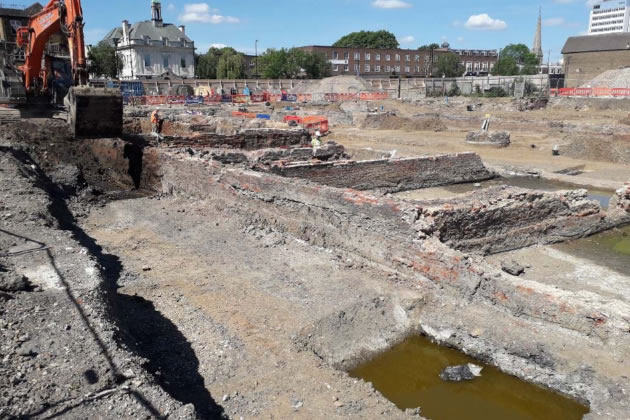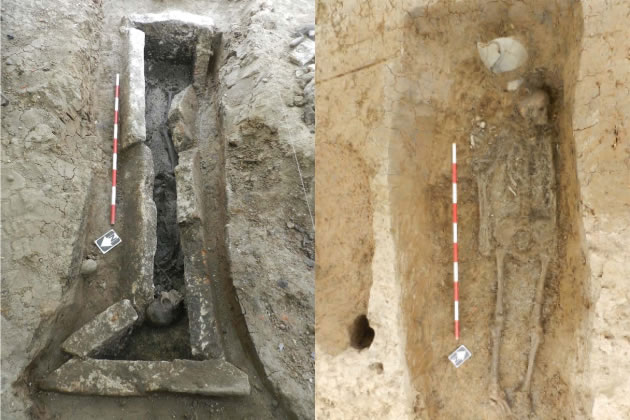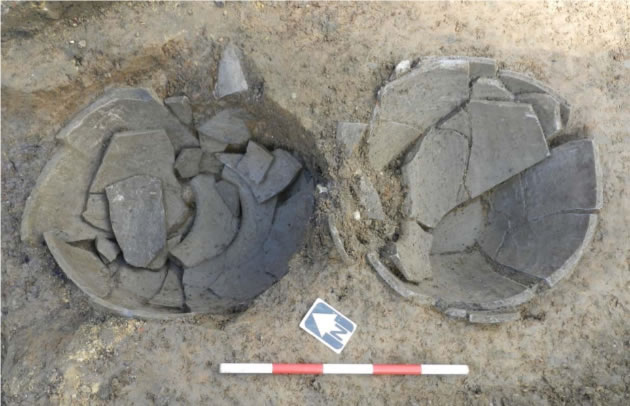Archaeological Finds Continue at Ballymore Development
Roman pots and a skeleton in a sarcophagus among the recent discoveries

The dig has revealed was dating to the 18th and 19th centuries. Picture: MOLA
March 3, 2023
Archaeologists working at the site of the Brentford Project development are continuing to discover more about the area’s past.
A recent report by Museum of London Archaeology has detailed a number of significant finds including Roman graves, pots and evidence of an extensive Roman field system in the area. One of the graves is of a skeleton in a sarcophagus and close by was found an earth cut grave with a smaller grave beside it believed to have been dug for a baby.
The report states, "Excavations found a possible prehistoric paleochannel through the southern part of the site, although only the northern edge of the channel was exposed. The site revealed evidence of Roman occupation, including an extensive Roman field system(s).
"Two Roman inhumations were found in Block B. Both were earth-cut graves containing female individuals who died in adulthood. One was buried in a large limestone sarcophagus and the other had possibly disturbed an earlier cremation burial. These burials were similarly orientated/aligned with nearby ditch systems and may have been contained within the remains of a small cemetery plot, possibly for a high-status family or kin group.
"Three distinct areas of clustered with stakes hole and/or post hole may offer some tentative evidence of very rudimentary late Roman or early medieval timber buildings and/or fence structures. Later medieval features may include an undated hearth, which could relate to a series of hearths dating to between the 12th and 13th centuries with associated stake holes found to the east in Block D. Other medieval features were mostly confined to isolated pits and residual pottery found within the fills of later cut features.”

The skeleton in a sarcophagus (left) and the earth cut grave with the hole next to it believed to have been for a baby (right). Picture: MOLA
Most of the finds at the site are from the post-medieval period including a late 16th to 17th century brick building in the north-east corner of Block B, as well as several 17th-century cess and rubbish pits. Brick walls, floor surfaces and drains were found associated with 18th and 19th century development, representing at least 13 buildings across the site which suggested the area had a focus on light industry.

Two Roman pots found recently at the site. Picture: MOLA
The continued finds confirm that human occupation has taken place in Brentford from pre-historical times and that Brentford was a significant population centre during the Roman period as it on the main route out of London west to Bath.
Like Reading Articles Like This? Help Us Produce More This site remains committed to providing local community news and public interest journalism. Articles such as the one above are integral to what we do. We aim to feature as much as possible on local societies, charities based in the area, fundraising efforts by residents, community-based initiatives and even helping people find missing pets. We’ve always done that and won’t be changing, in fact we’d like to do more. However, the readership that these stories generates is often below that needed to cover the cost of producing them. Our financial resources are limited and the local media environment is intensely competitive so there is a constraint on what we can do. We are therefore asking our readers to consider offering financial support to these efforts. Any money given will help support community and public interest news and the expansion of our coverage in this area. A suggested monthly payment is £8 but we would be grateful for any amount for instance if you think this site offers the equivalent value of a subscription to a daily printed newspaper you may wish to consider £20 per month. If neither of these amounts is suitable for you then contact info@neighbournet.com and we can set up an alternative. All payments are made through a secure web site. One-off donations are also appreciated. Choose The Amount You Wish To Contribute. If you do support us in this way we’d be interested to hear what kind of articles you would like to see more of on the site – send your suggestions to the editor. For businesses we offer the chance to be a corporate sponsor of community content on the site. For £30 plus VAT per month you will be the designated sponsor of at least one article a month with your logo appearing if supplied. If there is a specific community group or initiative you’d like to support we can make sure your sponsorship is featured on related content for a one off payment of £50 plus VAT. All payments are made through a secure web site. |